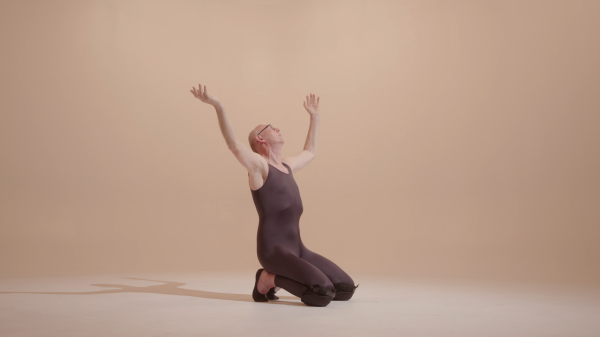
Save this storySave this storySave this storySave this story
At heart, “Dad Can Dance” intimately explores the relationship between craft and identity, the unfinishable, imperfectible task of self-discovery and self-invention.
In 2018, the artist and filmmaker Jamie Ross was headed to a residency at the Banff Centre for Arts and Creativity, where they intended to work on a project about poisonous and aphrodisiac plants. But Ross’s plans changed when they stopped along the way to have lunch with their father, David. Sitting at the kitchen table, David became unexpectedly emotional; he told Ross that he, too, had held a residency at Banff, forty-five years prior. He had studied ballet, but he ultimately quit, discouraged by teachers’ criticisms that his body—his instrument—was inadequate. This felt like a bombshell to Ross: though David, a financial consultant, had shared many memories of his youth, he had never mentioned his former life and dreams as a dancer. Reeling, Ross left for the airport, and upon arrival at Banff they headed almost immediately to the archives, seeking photographs from 1973. The work that Ross began that summer culminated in their documentary “Dad Can Dance,” co-directed with David Ross.
“This is a story about secrets,” Jamie proclaims, in voice-over, early in the film. In addition to David’s buried creative aspirations, he divulged that he had had an intimate relationship with a man—a fact that seemed significant to withhold, considering his fraught reaction when Jamie, as a teen-ager, came out as queer. “Dad Can Dance” is about reconciliation between parent and child as much as between past, present, and future selves. Though colored by loss, regret, and questions of what might have been, the film is ultimately oriented toward joy and liberation, as David—encouraged by Jamie and a queer community of fellow-artists—begins to dance again.
The New Yorker Documentary
View the latest or submit your own film.

Amid a political landscape in which queer and trans people—and the families and communities who support them—are increasingly under attack, the filmmakers wanted “Dad Can Dance” to be accessible to a wide audience, affirming to those learning to accept themselves and instructive to those learning to accept others. But the film also challenges generic conventions of the coming-out narrative: rather than depicting a linear progression from repression to revelation, the Rosses stage a complex pas de deux between trauma and redemption, and, even while celebrating openness and pride, they privilege the right to privacy, to have parts of the self remain reserved or inscrutable. When David reconnects with an old flame, the details of their conversation—like those of their relationship—are allowed to remain vague. The point of unearthing this hidden history is not to overturn every stone but to excavate a long-interred sense of possibility, of love and freedom.
At heart, “Dad Can Dance” intimately explores the relationship between craft and identity, the unfinishable, imperfectible task of self-discovery and self-invention. The film finds an embodiment of David’s road not taken in the renowned ballerina Evelyn Hart, another Banff alum, who reflects on the punishing yet rewarding path of a professional dancer. “It’s about having the opportunity to be able to share that depth inside of yourself with other people,” Hart explains. “What’s most important, I think, is that those people come to recognize to have the courage to be themselves.” Art helps humble us in the face of every individual’s unknowability, including our own; David’s story, and Jamie’s, shows how even the rifts in understanding that most powerfully estrange us can—with practice—become sites of profound inspiration, collaboration, grace.
Sourse: newyorker.com